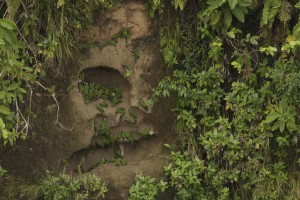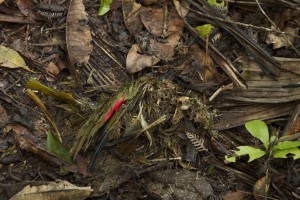We are off to the Galapagos Islands today and will be remaining there for 5 days.
During that time there will be no internet so obviously no more postings. We return on November 4th so will catch up at that time.
We will talk to you then!
We are off to the Galapagos Islands today and will be remaining there for 5 days.
During that time there will be no internet so obviously no more postings. We return on November 4th so will catch up at that time.
We will talk to you then!
Over the past week and a half we have crossed the equator, back and forth, several times. Today we visited at the actual equator monument here in Quito. First the old site determined in the 1800 then the real site according to GPS. At the real line they did a little water exercise to show the affects of water draining in the north and south hemisphere. On the actual line the water goes straight down the pipe, at least it did in the demonstration. When they moved the pan of water 10 feet to the south it went down the drain clockwise and when they moved the pan of water 10 ft north of the line it went down the drain counter clockwise. But I call BS as it look like the pan was level on the line but slightly sloped at the demonstration sites for the north and south hemisphere. 10 ft can’t make that kind of difference besides I think it isn’t actual true according to a book I read. (that is just me.) However it did do in the demonstration.
OK here is the old monument and the line:
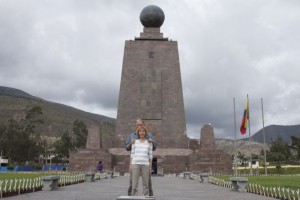
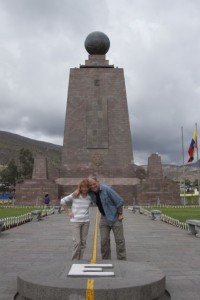
Now the real line: the ability to use GPS to establish the actual line moved it 150 ft to the north. This is where they did the demo on the water draining from the pan.
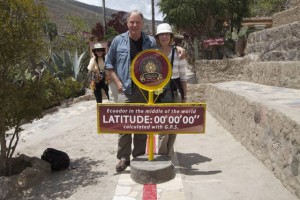
Now a subject that we haven’t talk about much in this trip. We stopped at a “Bano” for a break at the highest point along our trip through the park.
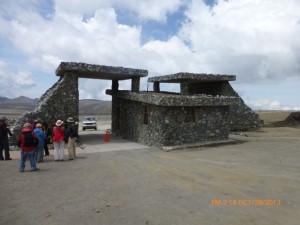
As you can see it is over 14,000 ASL and that is a fair bit. Now when we first arrived at Quito, which is 9,350 ASL, it was noticeable right away. First, slight headache and and secondly we both felt a little tired but in fairness we had just came off the plane so we didn’t really see that as an effect. We got use to this fairly quickly and now, just arriving here for the third time it is completely unnoticeable. What we have been told is that one is never sure how altitude might affect you and that everyone is completely different, in fact I notice it more than Berniece does. Also what has been told to us is that over 10,000 ASL the effect is exponential so when we got to the 14,000 ft level we expected the altitude difference to be quite noticeable, (of course we have pills for altitude sickness), but I am happy to report our bodies did not react negatively to that altitude. I did notice my shoes were a little heavier and I found myself feeling out of breath but it was just that sensation of being out of breath. Berniece has not had the same issue or sensation. All in all we are happy because we still have a lot of sights to see and they are very high up.
Along the road through the Chimboraso National Park we could see first hand the many layers created by the lava flows throughout history. The road cuts were perfect places to see this and marvel at the many patterns nature created during very massive violent eruptions.
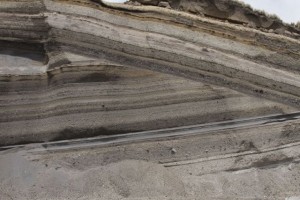
The other wonderful thing that we experienced was to see the only wild cameloid, the Vicuna. They are hard to get close to but we did get some great pictures!
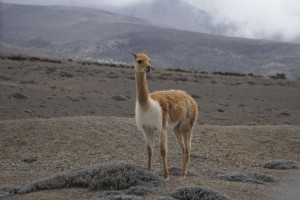
On our way back to Quito we had a chance to learn at little bit about our “pets” the Guinea Pig. First of all you need to understand the the indigenous people in the Andes raised Guinea Pigs much like we raise chickens; well not quite the same as they kept them in their huts. Guinea Pigs are like rabbits when it comes to reproduction so they of course had a very cheap food supply. They feed them their vegetable scraps and allowed them to reproduce rapidly, after they reached maturity they would eat the old ones, again like we do chicken. So what you feed you eat, makes a lot more sense than having pets around the house for little purpose, (just trying to get a rise out of everyone!). Well anyway for lunch we stopped at a restaurant and tried them ourselves, very tasty I must admit!
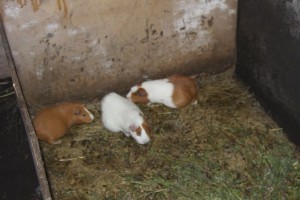
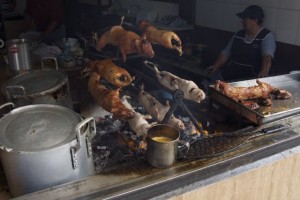
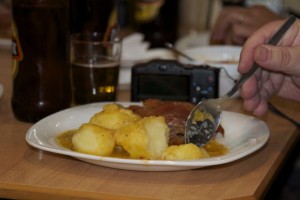
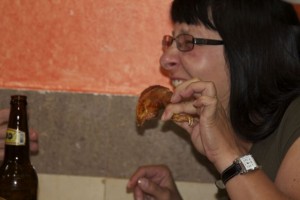
I am not sure that the pictures that we took of this portion of the trip really do it justice. To see the mountain gardens, so steep even a goat couldn’t climb it, (well not really), and they are farming the land. Let’s start at Banos where we spent a leisurely morning visiting the downtown and then a small hike, (very small at this altitude), to get a few pictures of the town. This is a very friendly town and is well known for the very hot and wonderful hot-springs that bubble out of the mountain side. No surprise of course as we are in the valley of volcanoes still and there is one, not to far away, that is very active, like every ten minutes.
After our downtown walk and the short hike we had a quick lunch then on to Riobamba. On the way we stopped at a old train station and met a very strange little man and his daughter. He is known as the “last ice merchant” his name is Baltazar Uscha he is 67 years old and has been getting ice off Mount Chimborazo to sell for 52 years. There is a You Tube documentary about him just google the “the last Ice Merchant”.
The story is amazing, this man and his daughter became quite famous after the documentary and they flew him to New York city for a presentation. Imagine someone who never had been farther than 50 miles from home going to NY City? anyway watch the You Tube!
By the way we were at 12600 ft above sea level at this point, noticeable to me at least.
The volcano, Mount Chimborazo is 20800 ASL, twice as high as Mount Baker! We got some great pictures after we got to Riobamaba because the clouds had finally lifted. On top of that we caught a glimpse of an active volcano erupting; some of our group got some great pictures early on but unfortunately because of timing Berniece and I only caught a steam eruption. Maybe tomorrow..we will try again.
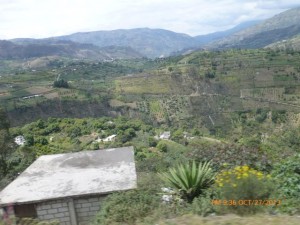
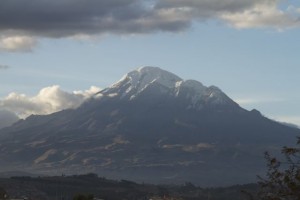
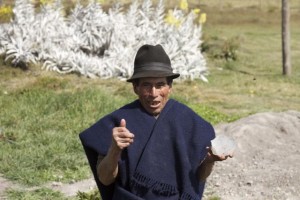
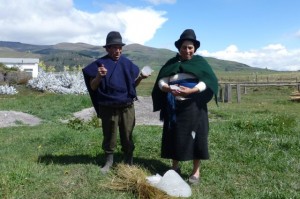
We stayed last night in a hosteria which is the name of a rural Inn. This Hacienda Chovali is one that housed Franciscans from Spain 400 years ago. It is now owned and operated by a family in the 6th generation.
Today we spent a few hours at the weekly market in Otavalo which is famous for the crafts created by the indigenous people of the area who speak the language called Quichua which is derived from the Incan language. A very colorful and busy place!
We traveled the Pan American highway on the road referred to as the Avenue of Volcanoes. It’s a valley that runs between two ranges with volcanoes on both sides, including Cotopaxi the highest active volcano in the world.
Our Hosteria tonight is La Cienega and we got the “Masters” room, or should we say apartment. Not sure why we got this room but it could because we are special people, oh well we will go with that. Really just the luck of the “room draw” quite nice and very much appreciated.
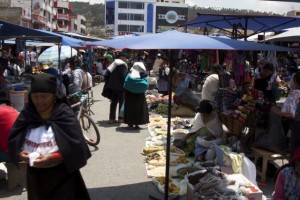
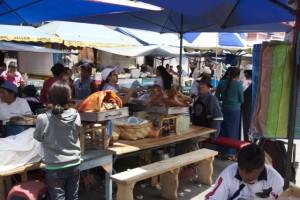
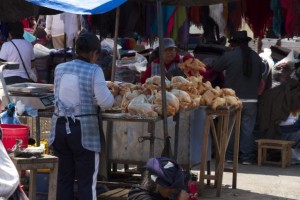
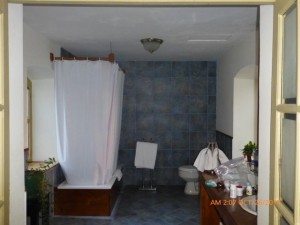
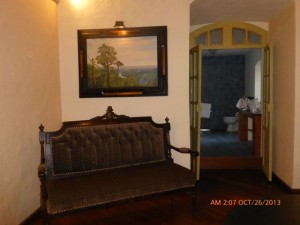
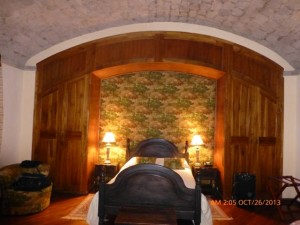
Time to say good bye, it was a great experience and we learned at lot. But the interaction with the naturalist and the local guide was where the value was really appreciated. They , Andres and Enrico, were superb. Yes, we know they do this for a living but we could also tell that they really enjoyed their work and that made all the difference.
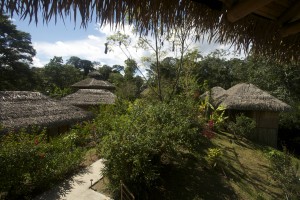
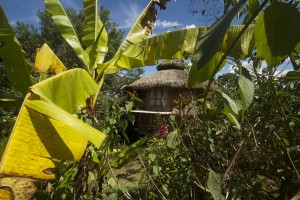
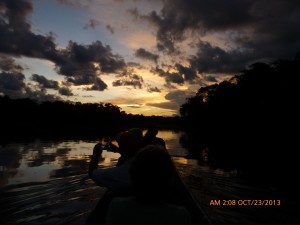
After the snake and bird show we went up the river to the village. Frankly this village reminded us of other similar places we had visited like Swaziland, the poverty and spirit. We went to the school and met some of the children; eat fresh sugar cane and fresh pineapple right out of their garden and talked to the locals. They insisted on us having lunch with them which was very interesting. The wrapped food had fish and palm hearts cooked inside and were delicious. The other products were the yuka, (much like our potato), cooked plantains and of course the roasted grubs. Now I would not have tried it but Berniece did so of course I had to. It was quite crispy on the out side and creamy, like butter, on the inside actually if you didn’t know it was the larva of a beetle you could really get to like it.
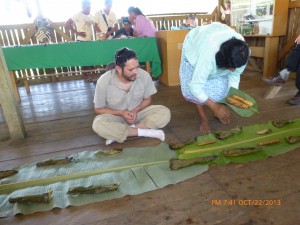
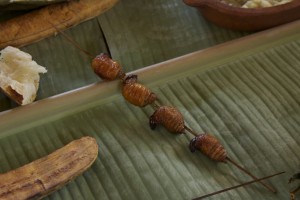
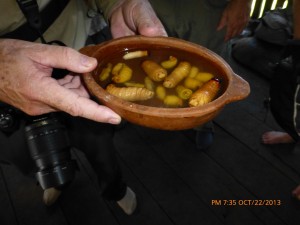
We got up very early to head out to the main river so that we could visit a “no contact” indigenous community. On the way we stopped at a Parrot and Parakeet lick. The birds get digestive minerals from the clay lick that are important to their diet and general health. They arrive at the same time, stay there for 15-20 minutes and then disappear back into the jungle. Of course their predictable habits do not go unnoticed by their natural predictor, the Bow snake, which sits patiently in the trees until one makes the mistake of landing on it. From the photos you can see what happens! It swallows it completely whole, digests the meat then regurgitates the skeleton, feathers beaks etc. Yuk! (Sorry Doris it is all part of the jungle).
